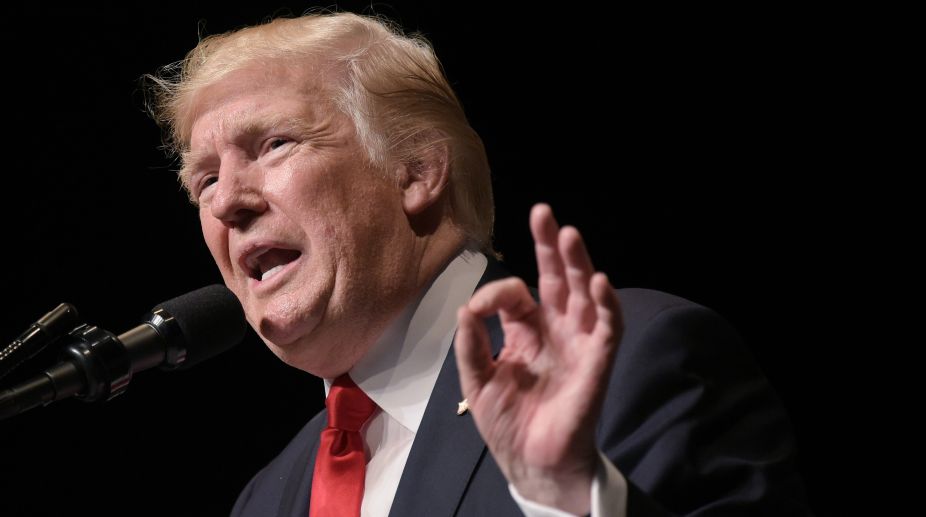Congress committing dacoity on rights of OBCs, SCs, STs: PM
“Wherever it (Congress) can do it, it will try to loot the claims of the SCs, STs and OBCs and give them to others,” said Modi.

US President Donald Trump (Photo: AFP)
There was a time when denial of US visa to then Gujarat chief minister Narendra Modi made news. It was denied in 2005 after the 2002 Gujarat riots. In early March 2013, the University of Pennsylvania cancelled a lecture by Modi. The West including the US, UK and the European Union had refused him visas. All this has changed since Modi became the Prime Minister in 2014. It is a fascinating story of rehabilitation of Modi on the world stage. He is now rubbing shoulders with world leaders, participating in several global summits.
Modi will visit Washington as Prime Minister for the fifth time to hold formal bilateral talks with the US President Donald Trump on June 26. They have had three phone conversations since Trump took over in January, but this will be their first faceto-face meeting.
While Modi is heading for Washington from a position of strength at home and after a successful tour of Europe, Trump is somewhat embattled on the home front. Modi had demonstrated that two major European powers – France and Germany – are well disposed towards Delhi. He will be wooing Portugal and Netherlands during his three-nation tour before going to the US. Trump, on the other hand, is under political stress due to allegations of Russia’s interference in the 2016 presidential elections. A Senate committee has been holding hearings and a special prosecutor is investigating the allegations.
Advertisement
For a showman like Modi this will be a low-profile visit. There will be no Madison Square Garden-like meeting where he wowed the Americans with his rock star status. Modi’s White House visit stands in contrast to those of Chinese President Xi Jinping and Japanese Prime Minister Shinzo Abe at Trump’s personal retreat, Mar-aLago in Florida playing golf in a more relaxed atmosphere. No meetings with large numbers of U.S. lawmakers are scheduled since the US Congress may be in summer recess, but interaction with some senior and influential senators and representatives is a possibility.
So what can one expect from this visit? Officially the External Affairs ministry has indicated, “their discussions will provide a new direction for deeper bilateral engagement on issues of mutual interest and consolidation of multi-dimensional strategic partnership between India and the US”. On the other side, White House press secretary Sean Spicer said, “President Trump looks forward to advancing our common priorities — fighting terrorism, promoting economic growth and reforms and expanding security cooperation in the Indo-Pacific region.” Actually, this is a get-toknow-Trump visit. Modi was on a first name basis with President Obama. He had eight meetings with Obama and travelled to Washington three times. Obama made a historic trip to India as the Republic Day chief guest in 2015. Ties between New Delhi and Washington warmed during the Bush and Obama years but obstacles have already emerged in the early months of the Trump presidency. Trump’s ‘America first’ and his declared immigration policy of cutting down H1B visas are causing concern in New Delhi as it may affect the Indian IT industry which has a large export market. From 2001 to 2015,workers from India received the largest share (50.5 per cent) of all H-1B visas for first-time employment.
Trump’s recent withdrawal from the Paris Agreement on climate change has also opened fissures between India and the U.S. Recently Trump had made some unpleasant remarks about India and China getting billions of dollar of help from the West, which India dismisses as untrue. Modi may have to correct this impression by explaining the actual position – that the total foreign aid and U.S. development assistance to India was minimal, while Indian defense and military purchases from the U.S. were in excess of $10 billion and Indian companies investing in the U.S. had created more than 300,000 American jobs.
Trade is another issue. The US’ goods and services trade deficit with India, ($42.3 billion last year), may also come up for scrutiny. US-India trade has grown six-fold since 2000, from $19 billion to $115 billion in 2016. In April, Trump ordered a review of trade with countries with which US runs a deficit. India is on that list.
The Trump-Modi meeting would focus on “continuity” in the relationship with consensus on policy issues like counter-terrorism. Modi has been raising the topic of terror with all global leaders whom he has been meeting of late. Ground had already been prepared during the recent visit of National Security Adviser H. R. McMaster. Defense Secretary Jim Mattis has stated that India is an indispensable partner in the AsiaPacific region.
Strengthening India’s military ties with Washington is another area of consensus. Defence ties have grown since the early 1990s and are growing. In 2016, Washington and New Delhi agreed to a deal that gives the latter the status of “Major Defense Partner.” This means that Washington will extend to New Delhi the same types of benefits including technology transfer as it does to its closest allies. The meeting should make it clear where each country stands in relation to the other on foreign policy issues. Just as Xi and Abe managed to establish a personal relationship with Trump, Modi too should try for it. Summit meetings between leaders often spring surprises. Who knows what will happen at the Modi-Trump meeting?
Advertisement